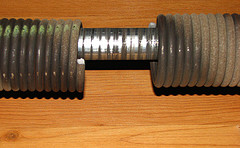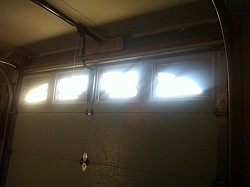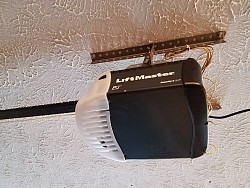ID a Faulty Garage Door Spring
 How often do you use your garage door? Even if you open and close it only when you're leaving for work or coming home, that's a total of approximately 500 times per year. All that wear and tear puts a lot of strain on your garage door springs, which act to counterbalance the door and hold it in place. If one of these springs breaks, you are stuck ... literally ... until you can get it replaced. Worse, malfunctioning springs are dangerous to cars and, scarier still, to humans.
How often do you use your garage door? Even if you open and close it only when you're leaving for work or coming home, that's a total of approximately 500 times per year. All that wear and tear puts a lot of strain on your garage door springs, which act to counterbalance the door and hold it in place. If one of these springs breaks, you are stuck ... literally ... until you can get it replaced. Worse, malfunctioning springs are dangerous to cars and, scarier still, to humans.
About Garage Door Springs
Springs maintain the equilibrium of your garage door, and are essential for its proper functioning and security. There are two types. Torsion springs, either singly or in sets of two, are used to hold a wide and/or heavy garage door (weighing 350-1000 pounds) in place. They are located on the wall directly above the door. Extension springs are used for smaller garage doors (usually 9' x 7' or less, or under 350 pounds) which are relatively lightweight. They are installed as pairs, one on each side of the door track.
The repair or replacement of a garage door spring is a complex task, which requires a great deal of expertise. If not done correctly, it will be hazardous to the safety of anyone using the door. The cost to replace garage door springs runs about $175-225, including labor, but will vary according to the size of your garage, the type of door, and your location.
Clues Your Spring May Be Faulty
Here are common signs that one of your garage door springs is faulty:
Your garage door does not open or close in response to the automatic opener, even though there is no mechanical fault in the device itself. NOTE: If this happens, do not try repeatedly to use your opener, because you may end up damaging it irreparably.
The door stops unexpectedly in the middle of opening.
The door looks like it is hanging crookedly.
There is a visible worn area or separation in the spring.
The spring appears elongated and irregular, and has lost its tension.
If you hit the door with your vehicle, this can cause the spring to fail.
Normal Lifespan
The expected lifespan of a torsion garage door spring is rated in terms of cycles. A cycle consists of a complete action of opening and closing. According to industry standard, the minimum life must be 10,000 cycles, but better quality springs may last as long as 100,000 cycles. This means that replacement of your garage door springs should be necessary after approximately 7-12 years, due to metal fatigue resulting from normal wear and tear.
Regular Maintenance
As with any piece of mechanical equipment, proper maintenance will both help garage door springs function and extend their lifespan. The springs, as well as the pulleys, bearings, and rollers, should be treated once or twice a year with a light silicone lubricant. Inspect them regularly for signs of wear.
When you need to replace your garage door springs, make sure that the correct size for your door's weight is installed. This will ensure smooth opening and closing, while it avoids damaging the opener. Even if only one of a pair of springs is broken, both should be replaced to ensure balanced tension. What's more, the two springs will have approximately the same lifespan, meaning that the other could break at any moment.
Laura Firszt writes for networx.com.
Looking for a Pro? Call us (866) 441-6648

Garage door Average Costs
Garage Door Pros Experiences

Emergency Garage Door Replacement

Garage Door Reinforcement Was A Fast And Effective Solution



